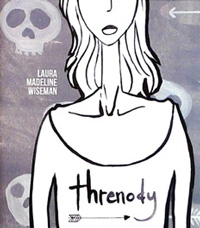Porkbelly Press, 2014
23 pages, $7
Review by Shinjini Bhattacharjee
The hallmark of a good piece of literature, especially poetry, is to exist by hiding its laws and code of conduct from its readers. These laws and rules, however, do not masquerade as imperceptible secrets, rather, peek from the corners of the big wide walls of pages, challenging the readers to demystify them. The interstices borne by these interactions offer the readers an opportunity to take refuge in the self-interpretation of a text, and in the process, rewrite it with the writer. Laura Madeline Wiseman’s latest chapbook, Threnody, published by Porkbelly Press, invites the readers to engage in such an exercise, and speaks volumes of Wiseman’s faith in her readers and her desire to engage them with the very fragments of her writing, and arrive at a collaborative interpretation in the process.
Threnody (from the Greek word thrēnōidia implying lament) is set in New Mexico and narrates the journey of the protagonist “I” who meets lady death, befriends her, and rides in her death cart. Wiseman is a brilliant poet, and this can be seen in the manner in which she constructs the fourteen micro-pieces. All of them carry a generous use of vowels and soft consonants, eerily highlighting the lament that lasts throughout the narrative.
The beginning of the first prose poem “In the House of Death”-“The lady of death wears a bonnet and dress as she tips forward to see the ground she passes, high on the cart”-sets the course that the rest of the poems fearlessly undertake. The descriptions of the protagonist’s self and the Other are terse, clever and vivid, and soon begin to merge into each other- “Maybe the lady of death lives inside us. She is a part of our muscles and bones” (“Or To Release Death”). The author uses the metaphor of lady death and the narrator’s relationship with her to highlight the ways in which the various forms of feminisms are constructed by society, and the painful and conflicting relationship women have with their psyche as a consequence. The chapbook interacts with women’s bodies, sexualities and normative social mores, holding them up for a critical examination. Even though the narrator fears lady death throughout the narrative, there is also an accompanying awe and fascination accompanying it, especially the manner in which the latter constructs her body and self (“I’m awkward. I stare, can’t breathe. You’re the one everyone adores”). The lady-death might even be seen as the narrator’s alter-ego, eschewing the familial to embrace a more radical relationship (“I say, I don’t want a sister. I want a friend, death’s bright angel, you”). The narrator paradoxically can only come to terms with her own identity by “let[ting] go” of it.
A perusal of the chapbook is both an aesthetic as well as an emotional experience. Even though the character and settings evoke beautiful mythic dimensions, their intentions are familiar and highly intriguing. These force you to question the underlying assumptions of a heteronormative, largely patriarchal society that works overtly by being covert. Highly reminiscent of the poems by Emily Dickinson, Sylvia Plath and H.D., Wiseman’s vignettes astutely engages in an intense description of surroundings and experiences in a struggle to find an identity of the self. What also lends a greater reading experience is the juxtaposition of the sparse, limited landscape of the chapbook with the always moving death cart in which the lady of death and the narrator travel, along with a choice of words and sentences that defy meaning and choose to tumble over each other instead of restraining themselves in confined ideologies and lexicons.
Feminism is a much traversed territory, and over the decades, various meanings have been forcibly cramped into its vulnerable spaces. Wiseman’s Threnody, however, is unique in its compelling and contemplative use of imagery and interpretation to offer a bold and fearless perspective of the female psyche that resides in the underworld and all that it exhibits. A must-read.

